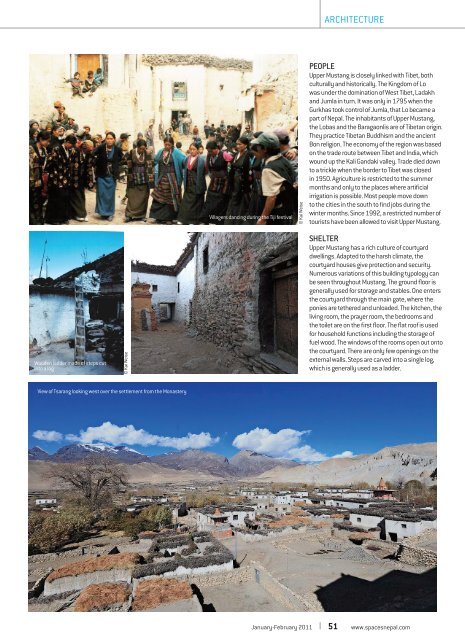1. Jan-Feb 2011
You also want an ePaper? Increase the reach of your titles
YUMPU automatically turns print PDFs into web optimized ePapers that Google loves.
ARCHITECTURE<br />
Villagers dancing during the Tiji festival<br />
© Kai Weise<br />
PEOPLE<br />
Upper Mustang is closely linked with Tibet, both<br />
culturally and historically. The Kingdom of Lo<br />
was under the domination of West Tibet, Ladakh<br />
and Jumla in turn. It was only in 1795 when the<br />
Gurkhas took control of Jumla, that Lo became a<br />
part of Nepal. The inhabitants of Upper Mustang,<br />
the Lobas and the Baragaonlis are of Tibetan origin.<br />
They practice Tibetan Buddhism and the ancient<br />
Bon religion. The economy of the region was based<br />
on the trade route between Tibet and India, which<br />
wound up the Kali Gandaki valley. Trade died down<br />
to a trickle when the border to Tibet was closed<br />
in 1950. Agriculture is restricted to the summer<br />
months and only to the places where artificial<br />
irrigation is possible. Most people move down<br />
to the cities in the south to find jobs during the<br />
winter months. Since 1992, a restricted number of<br />
tourists have been allowed to visit Upper Mustang.<br />
Wooden ladder made of steps cut<br />
into a log<br />
© Kai Weise<br />
SHELTER<br />
Upper Mustang has a rich culture of courtyard<br />
dwellings. Adapted to the harsh climate, the<br />
courtyard houses give protection and security.<br />
Numerous variations of this building typology can<br />
be seen throughout Mustang. The ground floor is<br />
generally used for storage and stables. One enters<br />
the courtyard through the main gate, where the<br />
ponies are tethered and unloaded. The kitchen, the<br />
living room, the prayer room, the bedrooms and<br />
the toilet are on the first floor. The flat roof is used<br />
for household functions including the storage of<br />
fuel wood. The windows of the rooms open out onto<br />
the courtyard. There are only few openings on the<br />
external walls. Steps are carved into a single log,<br />
which is generally used as a ladder.<br />
View of Tsarang looking west over the settlement from the Monastery<br />
<strong>Jan</strong>uary-<strong>Feb</strong>ruary <strong>2011</strong><br />
51<br />
www.spacesnepal.com

















